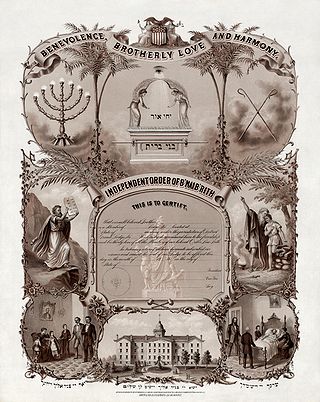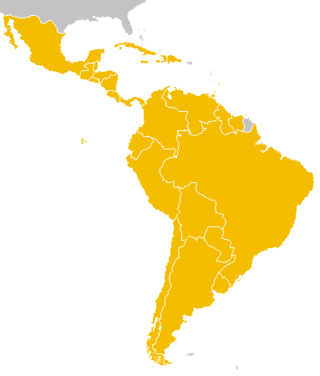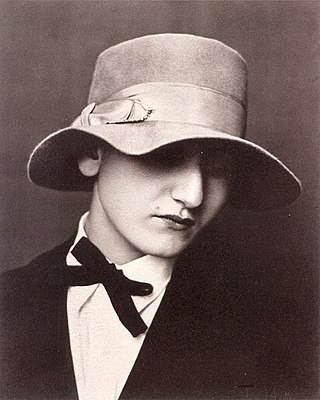Related Research Articles

Latin America are the countries and regions of the Americas where Romance languages—languages derived from Latin—are predominantly spoken. The term was coined in France in the mid-19th century to refer to regions in the Americas that were ruled by the Spanish, Portuguese, and French empires. The term does not have a precise definition, but it is "commonly used to describe South America, Central America, Mexico, and the islands of the Caribbean." In a narrow sense, it refers to Spanish America and Brazil. The term "Latin America" is broader than Hispanic America, which specifically refers to Spanish-speaking countries; and lesser than categories such as Ibero-America, a term that refers to both Spanish and Portuguese-speaking countries from Europe and Americas.

B'nai B'rith International is a 501(c)(3) nonprofit Jewish service organization and was formerly a German-American cultural association. B'nai B'rith states that it is committed to the security and continuity of the Jewish people and the State of Israel and combating antisemitism and other forms of bigotry.

BBYO is a Jewish teen movement, organized as a 501(c)(3) nonprofit organization and headquartered in Washington, D.C. The organization is intended to build the identity of Jewish teens and offer leadership development programs.

The Rio Group (G-Rio) was a permanent association of political consultation of Latin America and Caribbean countries, created in Rio de Janeiro, Brazil on December 18, 1986 with the purpose of creating a better political relationship among the countries. It was succeeded in 2011 by the Community of Latin American and Caribbean States
Latin Americans are the citizens of Latin American countries.
The history of the Jews in Latin America began with conversos who joined the Spanish and Portuguese expeditions to the continents. The Alhambra Decree of 1492 led to the mass conversion of Spain's Jews to Catholicism and the expulsion of those who refused to do so. However, the vast majority of conversos never made it to the New World and remained in Spain slowly assimilating to the dominant Catholic culture. This was due to the requirement by Spain's Blood Statutes to provide written documentation of Old Christian lineage to travel to the New World. However, the first Jews came with the first expedition of Christopher Columbus, including Rodrigo de Triana and Luis De Torres.
Jewish Cubans, Cuban Jews, or Cubans of Jewish heritage, have lived in the nation of Cuba for centuries. Some Cubans trace Jewish ancestry to Marranos who came as colonists, though few of these practice Judaism today. The majority of Cuban Jews are descended from European Jews who immigrated in the early 20th century. More than 24,000 Jews lived in Cuba in 1924, and still more immigrated to the country in the 1930s. Following the 1959 communist revolution, 94% of the country's Jews emigrated, most of them to the United States. In 2007 an estimated 1,500 known Jewish Cubans remained in the country, overwhelmingly located in Havana. Several hundred have since immigrated to Israel.

The Latin American and the Caribbean Economic System, officially known as Sistema Económico Latinoamericano y del Caribe (SELA), is an organization founded in 1975 to promote economic cooperation and social development between Latin American and the Caribbean countries. In the early 1990s, its representatives consisted of members from 28 countries and took part in the General Agreement on Tariffs and Trade (GATT) negotiations, which led to a new global agreement on restrictions on trade and established the World Trade Organization (WTO).
The Christian Democrat Organization of America is an international organization made up of political parties, groups, and associations in North America and South America that promote the principles of Christian humanism. Affiliated with the Center Democratic International, it is a regional partner of the European People's Party and regional organizations of Christian Democratic parties in Asia and Africa.
Latin American literature consists of the oral and written literature of Latin America in several languages, particularly in Spanish, Portuguese, and the indigenous languages of the Americas. It rose to particular prominence globally during the second half of the 20th century, largely due to the international success of the style known as magical realism. As such, the region's literature is often associated solely with this style, with the 20th century literary movement known as Latin American Boom, and with its most famous exponent, Gabriel García Márquez. Latin American literature has a rich and complex tradition of literary production that dates back many centuries.

Historically speaking, bilateral relations between the various countries of Latin America and the United States of America have been multifaceted and complex, at times defined by strong regional cooperation and at others filled with economic and political tension and rivalry. Although relations between the U.S. government and most of Latin America were limited prior to the late 1800s, for most of the past century, the United States has unofficially regarded parts of Latin America as within its sphere of influence, and for much of the Cold War (1947–1991), actively vied with the Soviet Union for influence in the Western Hemisphere.

The history of the Jews in Mexico began in 1519 with the arrival of Conversos, often called Marranos or "Crypto-Jews", referring to those Jews forcibly converted to Catholicism and that then became subject to the Spanish Inquisition.

Anita Brenner was a transnational Jewish scholar and intellectual, who wrote extensively in English about the art, culture, and history of Mexico. She was born in Mexico, raised and educated in the U.S., and returned to Mexico in the 1920s following the Mexican Revolution. She coined the term 'Mexican Renaissance', "to describe the cultural florescence [that] emerged from the revolution." As a child of immigrants, Brenner's heritage caused her to experience both antisemitism and acceptance. Fleeing discrimination in Texas, she found mentors and colleagues among the European Jewish diaspora living in both Mexico and New York, but Mexico, not the US or Europe, held her loyalty and enduring interest. She was part of the post-Revolutionary art movement known for its indigenista ideology.

Emigration from Uruguay is a migratory phenomenon that has been taking place in Uruguay since the early 20th century.
The Permanent Congress of Trade Union Unity of Latin America also known as the Congreso Permanente de Unidad Sindical de los Trabajadores de América Latina y el Caribe (CPUSTAL) is the Latin American regional organizations of the World Federation of Trade Unions.

The Italy–Latin America Conference or Italo–Latin America Conference, formally the Italy–Latin America and Caribbean Conference, is an inter-governmental forum for encounter between Italy and the countries of Latin America. A biennial summit is organised in Italy by the "Italo-Latin American Institute" located in Rome, with many initiatives marking the "preparatory path". The institute's aims are to develop and coordinate research and documentation regarding the problems, achievements and prospects of its Member Countries in cultural, scientific, economic, technical and social contexts. The conferences are an effective and well-established policy instrument in Italy’s relations with the countries of Latin America and the Caribbean.

The term Latin America and the Caribbean (LAC) is an English-language acronym referring to the Latin American and the Caribbean region. The term LAC covers an extensive region, extending from The Bahamas and Mexico to Argentina and Chile. The region has over 670,230,000 people as of 2016, and spanned for 21,951,000 square kilometres (8,475,000 sq mi).
B'nai B'rith in Cuba, is a regional division of B'nai B'rith, an international Jewish social service organization, that was founded in 1943.
B'nai B'rith in Europe, a regional division of B'nai B'rith, an international Jewish social service organization. The first B'nai B'rith lodge ever established outside of the United States was in Berlin in 1882. A central entity known as B'nai B'rith was established in 1999. Activities of the central B'nai B'rith Europe include co-organizing the European Day of Jewish Culture. The event was originally a 1996 initiative known as European Jewish Heritage Day and was launched by B'nai B'rith Europe in France.
B'nai B'rith Israel was founded in 1888 as a regional division of B'nai B'rith International, a Jewish social service organization. It has been active in the State of Israel throughout the 20th Century and to the present day.
References
- ↑ Postal, B. (1943). B'NAI B'RITH: A Century of Service. The American Jewish Year Book, 97-116.
- 1 2 3 "Manual de la B'nai B'rith" (PDF). B'nai B'rith Chile. 1963.
- 1 2 3 4 5 6 Levy, H. W. (1992). B'nai B'rith on the European continent after World War Two. Nordisk Judaistik/Scandinavian Jewish Studies, 13(2), 101-126.
- ↑ Zepp, S. (2021) Brazilian Editions of Hebrew Poetry (1962–1969). In G. Guerrero, B. Loy & G. Müller (eds.) Latin American Literatures in the World, Vol 8.
- ↑ "Cornerstone for New B'nai B'rith Home Laid in Santiago". Jewish Telegraphic Agency. 30 Aug 1962.
- ↑ Beller, J. (1969). Jews in Latin America.
- ↑ Kaplan, D. E. (2001). The Jews of Cuba since the Castro Revolution. The American Jewish Year Book, 101, 21-87.
- ↑ Arellano, M. L. (2020). Anita Brenner, correspondent to B'nai B'rith in Mexico during the 1920s: women immigrants, white slave traffic, and rumours. Women's History Review, 1-16.
- ↑ Roniger, L. (2010). Latin American Jews and processes of transnational legitimization and de‐legitimization. Journal of Modern Jewish Studies, 9(2), 185-207.
- ↑ Blank, L. (1993). The Integration of Ashkenazi and Sephardi Jews in Venezuela through the Decision-Making Process in the Educational System. Jewish Political Studies Review, 209-247.
